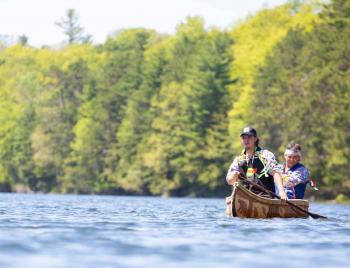Image Caption
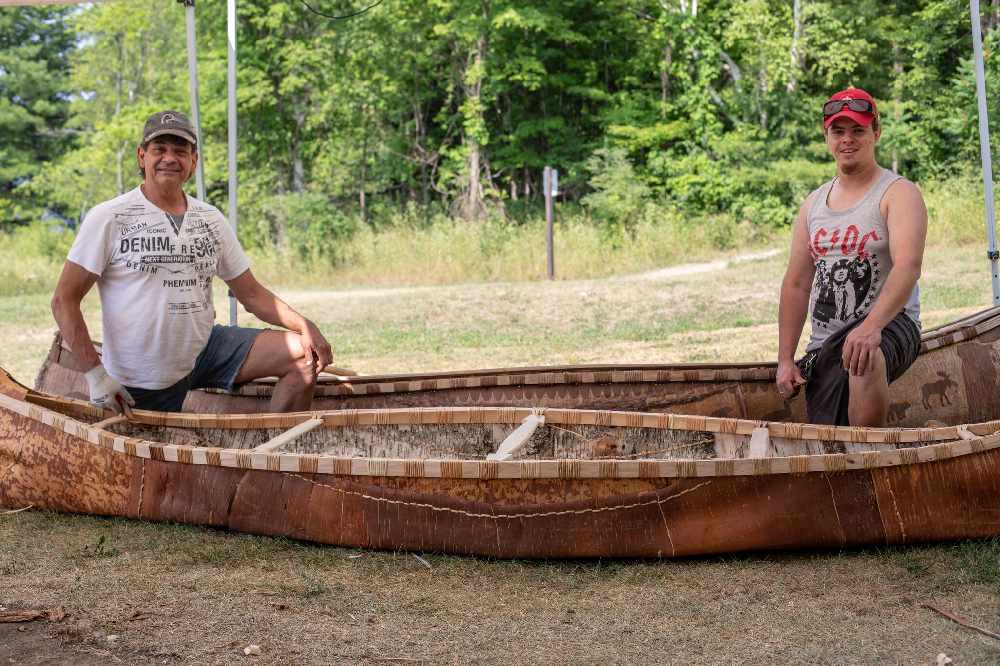
Chuck Commanda and Cole Williams with the birchbark canoe constructed at Murphy's Point Provincial Park.
By Erin Fitzgibbon
Windspeaker.com Contributor
“I don’t think that’s gonna float. Nope, it’s not gonna work. Not with a hole that size in the bark.”
The man shook his head with skepticism. He and his family stopped to assess the progress of a birchbark canoe being built. The hole in the bark was large, but the man didn’t know who was building the canoe.
The vessel sat under the pavilion waiting for morning and the return of the master builder. This man had such little faith in the process. He didn’t know the builder, and he didn’t know just how much experience and knowledge the builder possessed.
The builder in question was Chuck Commanda, one of the few people building traditional birchbark canoes in Ontario. Chuck is originally from Kitigan-Zibi in Quebec. He learned the craft from his grandparents William and Mary Commanda.
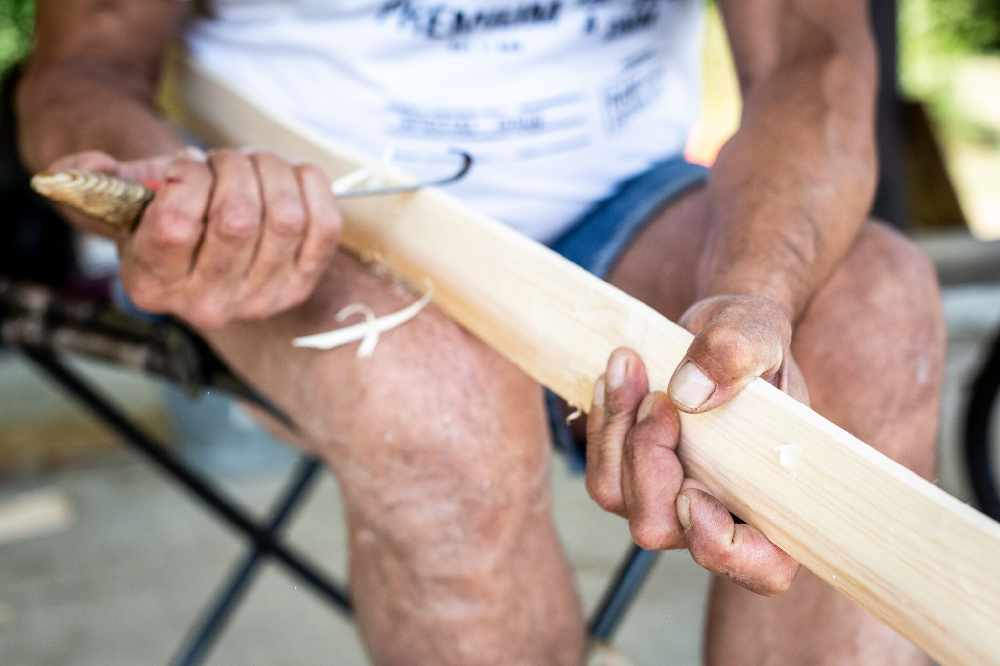
Chuck Commanda at work.
William showed him the techniques, but it was Mary that had the patience to explain the process and to help him learn. Without her, the craft might well have been lost. He speaks quietly about their influence on his current endeavour, and it is obvious the pair were central to teaching Chuck about the process of canoe building and about being proud of who you are.
In a conversation held under the pavilion at the main beach of Murphy’s Point Provincial Park, Chuck told his story. He explained that there are only a handful of canoe builders in Ontario and the majority have learned from books. They’ve practice techniques; struggled and learned from trial and error.
Chuck, however, was taught traditional methods and learned to build the canoes. He credits his grandmother with teaching him the most. She would explain why things were done as they were. She made the process logical and clear. Today he works on canoes and uses all that his grandparents passed down to him to create beautiful Algonquin canoes, and birchbark baskets. Chuck builds by feel, by instinct and careful assessment of the natural materials he harvests.
This most recent build occurred because of a chance meeting. Chuck was approached by Tobi Kiesewalter, the Interpretive Naturalist for Murphy’s Point. Tobi suggested that Chuck explore the trees within the park.
Murphy’s Point sits on the unceded territory of the Algonquins of Ontario. The idea was to harvest all the materials locally and produce a canoe that would remain in the visitors’ centre. Tobi felt the park needed to improve the programming and include more Indigenous content. They searched through 12 different trees and found one that would be suitable.
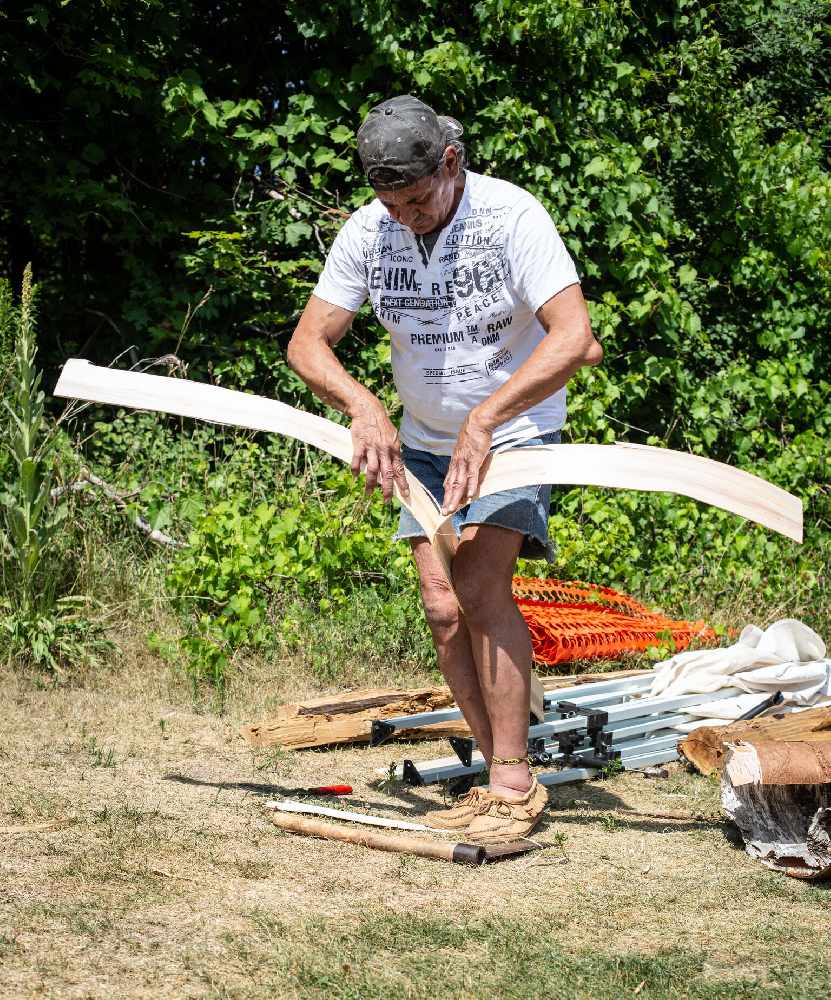
Chuck Commanda
As he worked with his handmade draw knife to share and prepare the cedar wood for the ribs of the canoe, Chuck discussed the continuing difficulty he experiences in finding suitable birch trees. It’s getting harder and harder to find birch trees that produce the right kind of bark for harvesting. He sees environmental factors as one of the major issues in finding suitable birchbark. You need a specific thickness and quality to the bark that is getting harder and harder to find. Chuck worries for the future of our environment.
Once the pair found a suitable tree, Tobi searched for and was able to obtain funding, and the summer interpretive program was born. For 14 days Chuck and his apprentice Cole Williams worked at the main beach building a canoe using materials harvested locally. The public had access to the build. They could witness the process first-hand, ask questions and be able to experience this ancient practice up close and personal.
The program seemed simple at first. It was a chance for park visitors to view an art form that many considered to be dead or dying. The build, however, went far beyond this kind of basic value. It’s a beautiful, creative process that requires an understanding of natural materials, chemistry when mixing fat with spruce gum, geometry and measurement.
Beyond the physical, there was also the cognitive value of the build. The program highlighted the history and the traditions of the Algonquins.
It was an opportunity for Chuck to share the culture and his knowledge with Indigenous youth. Chuck’s apprentice, Cole Williams, was on his third build. He had learned to make his draw knife, to select the right trees for harvesting raw materials, and to construct a canoe by feel rather than by using measuring tapes. Cole is learning the trade with the goal of returning to Curve Lake First Nation near Peterborough to share the process and the knowledge with the youth in his community. Cole knows the value of keeping traditional practices relevant.
“Building canoes isn’t dead. It’s alive, and it’s part of our culture. I want to share what I’ve learned with the younger kids back home.”
Chuck also taught some of the youth employed by the Indigenous youth employment program at the park. As a part of the program, the youth visited the build on several occasions. They laced the thwarts with spruce root and harvested spruce gum from the forest and happily engaged in the build. Chuck was careful to give them independence, but he also taught them the tricks of the trade.
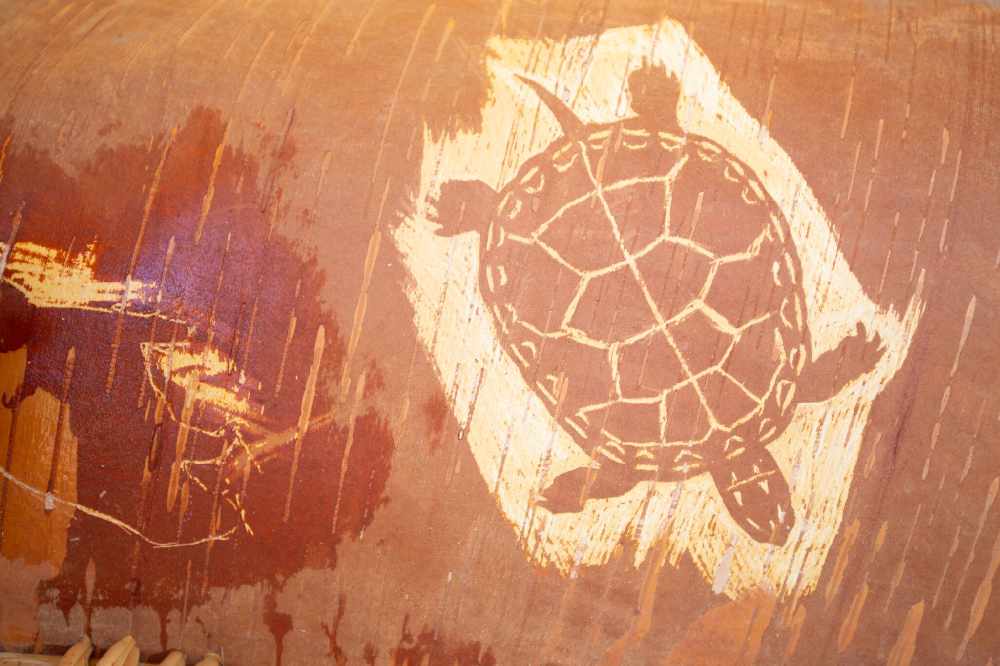
A turtle design scratched into the canoe.
The canoe build was also a way to speak out and defend the environment. Chuck hoped that visitors would walk away understanding the importance of sustainability. The canoes are created using local, natural elements. They come from the earth, and their impact on the planet is minimal.
Chuck wanted visitors to see that so much can be done with natural materials. Dependence on plastics and synthetics take away from a most important teaching. Chuck reminded visitors that Indigenous peoples believe strongly in caring for the planet so that the next seven generations will benefit from the resources.
Chuck explained how important it was to thank the tree for its help in building the canoe. He left behind offerings of tobacco and asked for the spirit of the tree to come and live in the canoe. Visitors were exposed to both the physical process of building the canoe, but also the cultural elements of the build.
For Tobi, the build was an opportunity to improve the park’s cultural programming. In the 23 years he’s worked at Murphy’s Point, he recognized a serious lack of Indigenous content within the park’s interpretive programming. When the opportunity came along to work with Chuck and develop the canoe building program, Tobi knew it was important.
“You can’t beat this kind of thing for sparking people’s interest. It’s relevant. It’s hands-on, and it’s an authentic experience.” Tobi also talked about the importance of programming that showed Indigenous culture in a modern context. He felt that this was just as important as showing the tradition.
The canoe was not the only thing created by Algonquin members. The paddles were handcrafted by Robin Tinney. He decorated the paddles with the eyes of a rat snake, one of the animals the park so proudly includes in it’s programming about the area. The paddles were unveiled on the day of the launch, July 20.
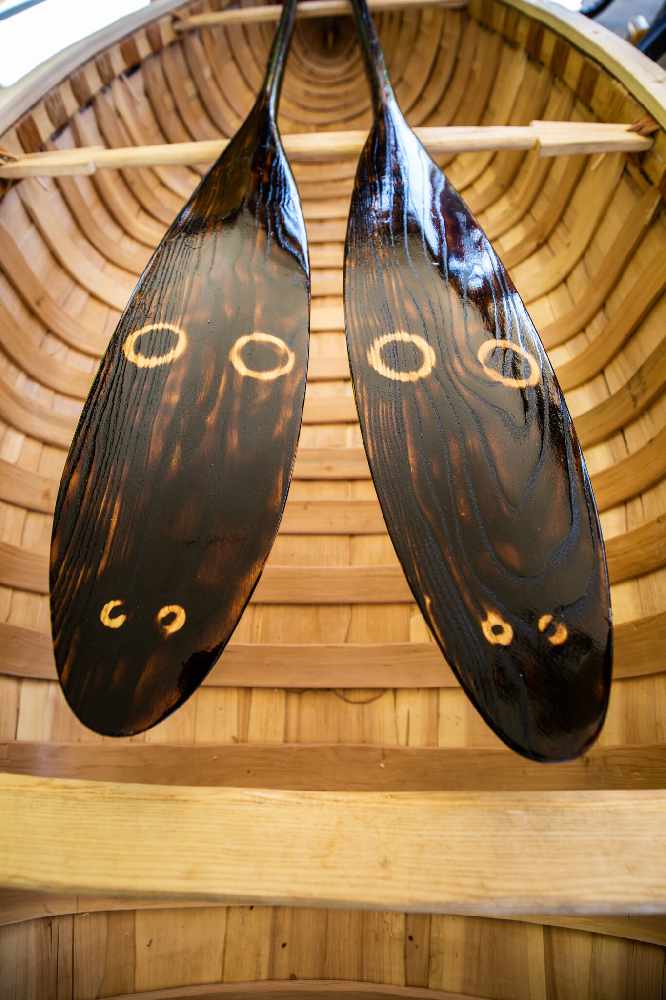
Paddles handcrafted by Robin Tinney.
On the day of the official launch of the canoe, both the public and members of the Indigenous community gathered in a large circle on the beach. The canoe sat in the centre. Larry McDermott spoke to the crowd. He thanked Cole, Chuck and the staff of Murphy’s Point for putting together such a significant experience for both the Indigenous peoples involved, as well as the general public.
The smudging experience was explained and all who wished to take part could do so. As Chuck and Cole moved around the circle, Larry spoke about the past and explained the wampum belt concept.
The canoe and the building of these traditional crafts can serve as vessels for reconciliation. Without the canoe, those explorers pressing to reach the west coast would have taken far longer to reach their goal. The canoe helped forge the roots of Canada.
By sharing his knowledge with others, Chuck feels the canoe brings people closer to reconciliation by leaps and bounds. Not the big political reconciliation seen on TV and in the news, but a closer personal connection that is truly authentic.
Chuck sees his craft as a method for bringing forward Indigenous values.
“We’re no longer second class citizens,” he explained. “We are here, and this is the way forward.”
The crowd of 200 people cheered as the canoe touched the water. They cheered even louder when Chuck and Cole paddled to the centre of the bay and raised their paddles in the air. Mission accomplished. Skepticism vanquished. The canoe glided through the water with grace.
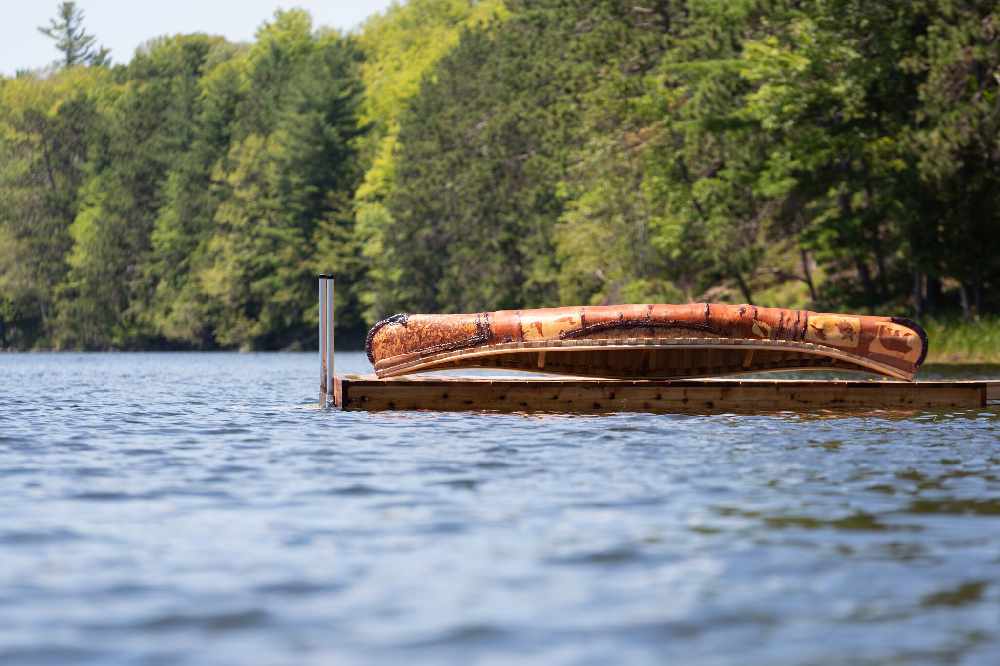
Photos by Erin Fitzgibbon

